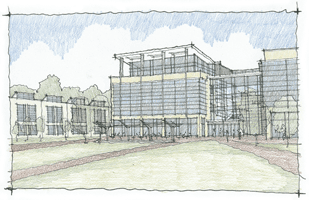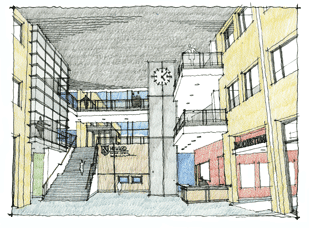Welcome to Jason Fair's AE Senior Thesis e-Portfolio
Building Statistics
- General Building Data:
- Building Name: Student Services Building
- Location and Site: Howard Community
College
10901 Little Patuxent Parkway Columbia, Md 21044 - Building Occupant Name: Student Support Services
- Occupancy or function: Business Occupancy
- Size : 101,405 sq ft
- Stories: 4 floors and basement MER, 5 total levels
- Primary Project Team:
- Owner: Howard Community College
- Construction Manager: Riparius Construction, Inc.
- Architect: Design Collective, Inc.
- Engineers:
- MEP: Mueller Associates, Inc.
- Structural: Smislova, Kehnemui & Associates
- Civil: Patton Harris Rust & Associates
- Geo Tech: Froehling & Robertson, Inc.
- Consultants: Birchfield Jacobs Foodsystems
Website: www.howardcc.edu
Website: www.ripariusconstruction.com
Website: www.designcollective.com
Website: www.muellerassoc.com
Website: www.skaengineers.com
Website: www.phra.com
Website: www.fandr.com
Website: www.birchfieldjacobs.com
- Dates of Construction: June 2005 to December 2006
- Actual Cost Data: $24,650,467 construction & related costs
- Project Delivery Method: Design-Bid-Build
Architecture Design and Functional Components:
 The Student
Services Building (SSB) at Howard Community College is the third building
that will make up the academic quadrangle. The first building in this quadrangle
to the northeast of the Student Services Building is the Instructional Laboratory
Building, which was completed in 2003. The next building to the south of the
SSB is the Visual Arts Building, which is currently under construction. Having
the Student Services Building on the western end of the quadrangle encloses
the space but also allows for a more inviting main entrance from this side
of the campus. The quadrangle is the first area one will enter after exiting
from the parking lot. The materiality of the Student Services Building is
similar to that of the Lab and Arts buildings. Also by breaking up the facade
with large central atrium spaces, the buildings surrounding the quadrangle
become less dominate and develop into a warmer and more welcoming backdrop.
The Student
Services Building (SSB) at Howard Community College is the third building
that will make up the academic quadrangle. The first building in this quadrangle
to the northeast of the Student Services Building is the Instructional Laboratory
Building, which was completed in 2003. The next building to the south of the
SSB is the Visual Arts Building, which is currently under construction. Having
the Student Services Building on the western end of the quadrangle encloses
the space but also allows for a more inviting main entrance from this side
of the campus. The quadrangle is the first area one will enter after exiting
from the parking lot. The materiality of the Student Services Building is
similar to that of the Lab and Arts buildings. Also by breaking up the facade
with large central atrium spaces, the buildings surrounding the quadrangle
become less dominate and develop into a warmer and more welcoming backdrop.  After walking through the quadrangle one will enter the SSB at the lower level, your gaze looks upward to the vast atrium space and ceremonial stair case which connects to the upper lobby. Other features of the lower level are the welcome center, campus security, book store, and the main dining facility.
The second floor offers a lobby directly off of the parking lot. Further services adjacent to this lobby are the records and registration department, admissions and advising department, financial aid department, and the finance department.
The third floor houses the test center and academic support, and the counseling and career services. This floor gives a completely different perspective of the atrium space observed at the entrances.
The features of the fourth floor truly cater to the needs and hungers of the students. There is a large and a small private dining room located on this floor which is supported by the lower level dining facilities via elevators and a service corridor. The main feature of this floor is the large dining room which opens out to a roof terrace where one can obtain a bird's eye view of the quadrangle.
After walking through the quadrangle one will enter the SSB at the lower level, your gaze looks upward to the vast atrium space and ceremonial stair case which connects to the upper lobby. Other features of the lower level are the welcome center, campus security, book store, and the main dining facility.
The second floor offers a lobby directly off of the parking lot. Further services adjacent to this lobby are the records and registration department, admissions and advising department, financial aid department, and the finance department.
The third floor houses the test center and academic support, and the counseling and career services. This floor gives a completely different perspective of the atrium space observed at the entrances.
The features of the fourth floor truly cater to the needs and hungers of the students. There is a large and a small private dining room located on this floor which is supported by the lower level dining facilities via elevators and a service corridor. The main feature of this floor is the large dining room which opens out to a roof terrace where one can obtain a bird's eye view of the quadrangle.
Primary Engineering Systems:
- Construction: No building construction had occurred as of the date of my site visit, only site work had begun.
- Electrical: Primary electrical service for the building is provided from the campus 13.2kV distribution system. Two medium voltage feeders will be extended from the switchgear serving the Arts & Humanities Building to a switchgear serving the Student services building. The switchgear is equipped to energize the building from either feeder. A single medium voltage feeder will run from the switchgear to the to a secondary unit substation in the main electrical room located in the basement. The building voltage distribution will be 480Y/277 volts. Power distribution systems will have 20% minimum spare capacity and panel boards will have minimum 20% space for future circuit breakers. Duplex receptacles will be 20 amp 120 volt heavy-duty type. Emergency power will be supplied by an outside diesel generator. All emergency systems and legally required systems will be supported by the generator.
- Lighting: In general lighting throughout the building will be fluorescent using typical 4ft T8 lamps, compact fluorescent lamps, and electronic ballasts. Power connections will be provided for display lighting in the bookstore. Controls will be provided in the atrium space to automatically adjust lighting levels to allow for natural light. Emergency lighting and exit signage will be supplied from unswitched branch circuits in the emergency panelboards. Exterior lighting will be metal halide to illuminate building entrances, walkways, and the parking lot. Control of exterior lighting is provided by a photocell and a time clock.
- Mechanical: The overall design goal for the mechanical and electrical systems is energy conservation. Therefore ASHRAE Standard 90.1 will be adhered to in addition to other energy conservation techniques. The chilled and condenser water will be provided by a stand-alone chilled water plant since campus service is not available. This plant will be located in the basement level mechanical room and will be linked to the chilled water plant in the basement mechanical room of the adjacent Arts Building. This allows select loads in each building to remain uninterrupted in the event of a failure of one plant. The heating water system will be operating year round to meet the required heating loads. Two 3000MBH hot water boilers will be used to meet these demands. Each boiler will be able to operate on natural gas and No.2 oil. The heated water will be supplied at 180°F and returned at 150°F. Six air handling units will be utilized to meet the required building loads. The air handling units will be ducted to air terminal units which service each zone.
- Structural: The foundation will be shallow spread footings or continuous strip footings. Slab-on-grade will be 5" thick, reinforced with 6x6 welded wire mesh and placed over vapor barrier and gravel. The second and third floors are 3-1/4" lightweight concrete over 3", 20 gage composite metal deck. The deck is typically supported by W18x35 beams bolted to W24x55 girders. Columns will typically be W10 wide flanges with wind moment connections. The fourth floor north section is typically W16x26 beams bolted to W21x44 girders. The south section is typically W18x35 beams connected to W24 wide girders. Roof construction is comprised of 3", 22gage metal deck over steel beams.
- Plumbing: A 6" service main will extend from the existing 8" campus main into the basement mechanical room. Domestic hot water will be supplied at a temperature of 110°F to the toilet rooms and at 140°F to the kitchen. All domestic water pipes will be copper with lead free solder joints and will be insulated. New plumbing fixtures will be provided and will be low flow water conserving type.
- Fire Protection: The fire detection and alarm system complies with the American with Disabilities Act Accessibility Guidelines and National Fire Protection Association (NFPA) 72. Alarm initiation devices include manual pull stations, smoke and heat detectors, duct smoke detectors. A smoke evacuation system required in the atrium space will exhaust the atrium at a rate of approximately 150,000 - 200,000 cfm. Entrance doors will automatically open to make up the exhausted air. A dedicated 6" fire main will be provided in the basement mechanical equipment room. Except for the telecommunications room the building will be equipped with an automatic wet pipe sprinkler system.
- Telecommunications:
The cabling and equipment for the telecommunications systems will adhere to EIA/TIA-569 the standard for spaces and pathways, and EIA/TIA-607 grounding and bonding requirements for telecommunications.
- Security Systems: Systems include card access control and door monitoring.